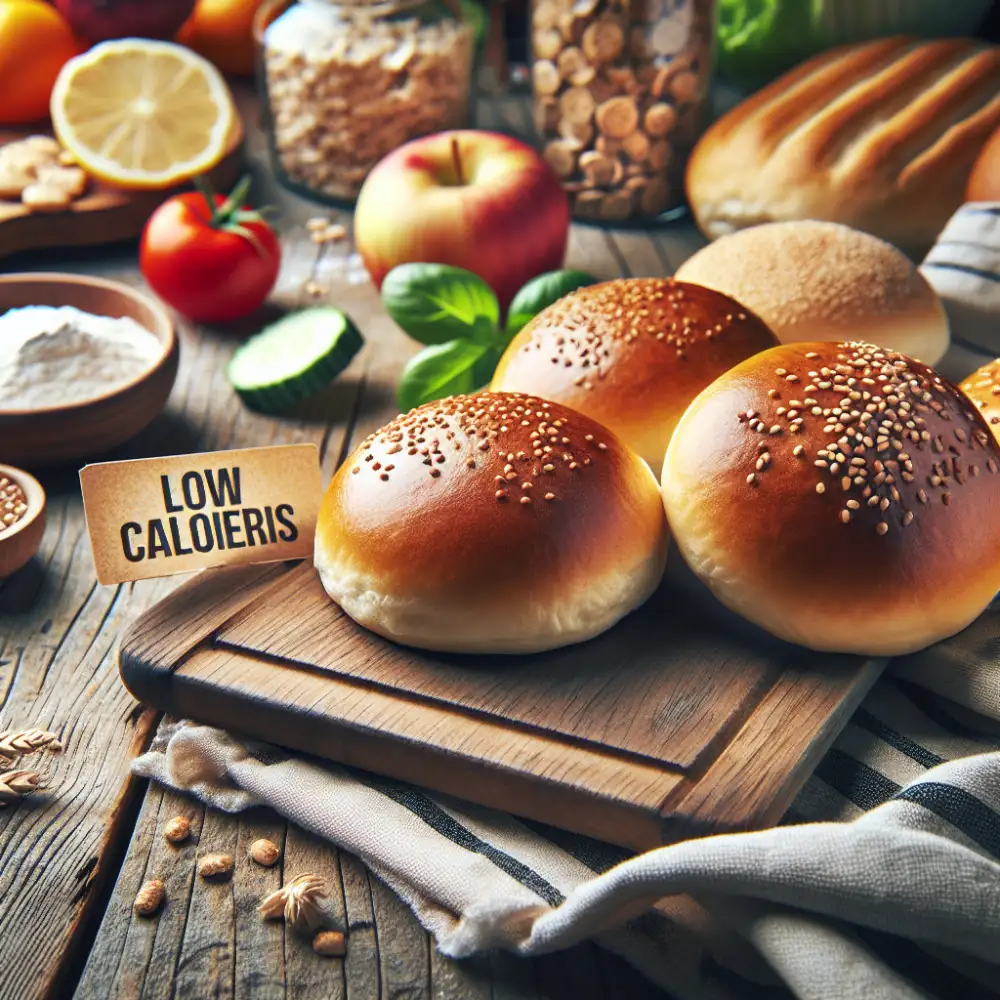Low-Calorie Buns for Guilt-Free Indulgence

Low-Calorie Bun Options
When watching your calorie intake, finding the right bun for your burger or sandwich can be tricky. Traditional white bread buns can pack a surprising number of calories. Luckily, there are plenty of delicious and satisfying low-calorie bun options available. Whole-wheat buns are a classic choice, offering more fiber and nutrients than white bread with a slightly nutty flavor. Look for "100% whole wheat" for the healthiest option. Another great choice is lettuce wraps. Using large lettuce leaves like romaine or butter lettuce as a wrap is a low-calorie and refreshing alternative. They add a satisfying crunch and work well with various fillings.
Portobello mushroom caps are a tasty and unique bun substitute. Grilled or roasted until tender, they have a meaty texture and savory flavor that complements many dishes. For a lighter option, try thin sandwich thins or wraps. These often have fewer calories and carbs than traditional buns. Look for varieties made with whole grains for added fiber. If you're looking for a gluten-free alternative, consider cloud bread. Made with eggs, cream cheese, and a few other ingredients, cloud bread is low in carbs and calories and has a light and airy texture.
Understanding Calories
Calories are the unit of measurement for the energy we get from food. When we eat, our bodies break down the food and convert it into energy to fuel our bodily functions. The number of calories in a food indicates how much potential energy it provides. When it comes to buns, traditional varieties can be relatively high in calories due to their carbohydrate content, primarily from refined flour.
Low-calorie buns, on the other hand, are designed to provide a lighter alternative. They typically achieve a lower calorie count through a combination of ingredient substitutions and modifications in the baking process. For instance, they may use whole wheat flour, which is higher in fiber and tends to be more filling, contributing to a sense of satiety. Some low-calorie buns may also incorporate ingredients like Greek yogurt or applesauce, which can add moisture and flavor while reducing the overall calorie content.
By choosing low-calorie buns, individuals watching their calorie intake can enjoy their favorite sandwiches and burgers without derailing their dietary goals. These buns can be a helpful tool for managing weight or simply making healthier choices. Remember that the total calorie content of a meal or snack will depend on the fillings and toppings used in conjunction with the bun.
Reading Nutrition Labels
When you're watching your calorie intake, choosing the right bread can be tricky. That's where reading nutrition labels becomes your best friend. Here's what to look for when comparing low-calorie buns:

Serving Size: Pay close attention to this, as it often trips people up. A serving might be one bun or half a bun, influencing the total calories listed.
Calories: This tells you the number of calories in a single serving. Aim for buns with 100 calories or less per serving for a lighter option.
Fiber: It aids digestion and helps you feel fuller for longer. Look for buns with at least 3 grams of fiber per serving.
Sugar: Added sugars can quickly increase calorie content. Choose buns with the lowest amount of sugar, ideally less than 5 grams per serving.
Ingredients: Scan the ingredient list for whole grains as the first ingredient. Watch out for long lists of unfamiliar additives and preservatives.
Remember, "low-calorie" doesn't always mean "healthy." A bun might be low in calories but high in refined carbs and low in nutrients. Opt for buns that strike a balance between lower calories and wholesome ingredients like whole grains and seeds.
Whole Grain Buns
For those watching their calorie intake, choosing the right bun can make a big difference. Whole grain buns, often touted for their fiber and nutrient content, can also be a smart choice for those seeking a lower-calorie option. But not all whole grain buns are created equal.
Look for buns that are specifically labeled as "light," "reduced-calorie," or "thin-sliced." These options are often lower in calories and carbohydrates compared to their regular counterparts. Pay close attention to the serving size, as it can vary significantly between brands.
When comparing different brands and types of whole grain buns, checking the nutrition label is key. Look for buns with fewer calories per serving, ideally around 100 calories or less. Additionally, consider the fiber content. Aim for buns with at least 3 grams of fiber per serving, as fiber can help you feel fuller for longer and contribute to a healthy digestive system.
Remember, even with lower-calorie options, portion control is essential. Enjoy your whole grain bun as part of a balanced meal, paired with lean protein, healthy fats, and plenty of vegetables.
Portion Control Matters
When it comes to enjoying your favorite meals, portion control can make all the difference, especially if you're watching your calorie intake. This is where low-calorie buns come in as a smart choice. Traditional buns can be surprisingly high in calories and carbohydrates, quickly adding up if you're not careful. By opting for low-calorie alternatives, you can still savor the goodness of a burger, sandwich, or slider without derailing your dietary goals.
These bun options are designed to provide the same satisfying texture and taste but with significantly fewer calories. They often achieve this through modifications in ingredients and baking methods. For instance, some low-calorie buns might incorporate whole grains, fiber-rich flours, or alternative sweeteners to lower their calorie count. Others might be smaller in size, making portion control more manageable.

By being mindful of your bun choice, you can easily shave off a significant number of calories from your meal. This can be particularly helpful if you're following a calorie-controlled diet or simply aiming to make healthier choices. Remember, small swaps like choosing a low-calorie bun can contribute to big differences in your overall well-being in the long run.
Healthy Bun Toppings
When it comes to enjoying a delicious bun, you don't have to sacrifice your healthy eating goals. Opt for whole-wheat buns or those made with alternative grains like oats or quinoa for a fiber boost that will keep you feeling fuller for longer and support healthy digestion. Look for buns that are specifically labeled as low-calorie or reduced-calorie. These options are formulated to provide the same great taste and texture while containing fewer calories.
Pile on the veggies! Load up your bun with a variety of colorful and nutrient-rich vegetables. Lettuce, tomato, onion, cucumber, bell peppers, and spinach are all excellent choices that add flavor, crunch, and essential vitamins and minerals. Mustard, hot sauce, and vinegar-based dressings are all flavorful options that are typically lower in calories and fat compared to mayonnaise-based sauces.
Be mindful of portion sizes to manage your calorie intake effectively. When using avocado or hummus, enjoy them in moderation to keep your calorie count in check. By making smart choices and opting for healthier toppings, you can enjoy your favorite bun without derailing your health goals.
Low-calorie buns: a testament to the fact that we can have our cake, or at least a healthy approximation, and eat it too.
Elara Nightshade
Avoiding Sugary Sauces
Many popular sauces, especially those used for dipping or drizzling, can quickly turn your low-calorie bun into a calorie bomb. Ketchup, barbecue sauce, honey mustard, and sweet chili sauces are often loaded with sugar. The good news is that there are plenty of tasty, low-calorie alternatives. Mustard, hot sauce, vinegar-based sauces, and Greek yogurt-based dips can add a burst of flavor without the extra calories. You can also experiment with making your own sauces at home using fresh herbs, spices, and low-calorie sweeteners like stevia or erythritol.
When eating out, be mindful of sauces that may be hiding hidden calories. Ask for your sauces on the side so you can control the amount you use. You can also request lighter options like mustard or vinegar instead of sugary sauces. Remember, a little awareness and planning can go a long way in enjoying your favorite foods while still maintaining a healthy lifestyle.


Smart Swaps for Flavor
Low-calorie buns can be a game-changer when you're craving your favorite burger or sandwich without the extra calories. But let's be real, sometimes they lack the flavor punch of their more indulgent counterparts. Fear not, because we've got some smart swaps to amp up the taste without sacrificing your healthy eating goals.
First off, don't be afraid to experiment with different types of low-calorie buns. Whole-wheat buns offer a nutty flavor and higher fiber content. Look for options with added grains and seeds for extra texture and taste. If you're feeling adventurous, try lettuce wraps or portobello mushroom caps as bun alternatives. They're naturally low in calories and bring a unique earthy flavor to your meal.
Now, let's talk toppings. This is where you can really get creative and add a burst of flavor. Instead of reaching for the mayo, opt for Greek yogurt or avocado spread for a creamy and healthy alternative. Load up on fresh veggies like juicy tomatoes, crisp lettuce, tangy onions, and crunchy pickles for added texture and nutrients. For a flavor explosion, experiment with different types of mustard, hot sauce, or vinegar-based relishes. And don't forget about herbs and spices! A sprinkle of dried oregano, basil, or chili flakes can make all the difference.
Enjoy in Moderation
Low-calorie buns can be a delicious and convenient option for those watching their calorie intake, but it's important to enjoy them in moderation. While they may contain fewer calories than traditional buns, they are still processed foods that may not provide all the nutrients your body needs.
| Brand | Product Name | Calories per Bun | Fiber (g) | Protein (g) |
|---|---|---|---|---|
| Example Brand A | Light & Fluffy Wheat Buns | 80 | 5 | 4 |
| Example Brand B | 100% Whole Wheat Low Calorie Buns | 90 | 3 | 3 |
It's crucial to pay attention to portion sizes and incorporate these buns into a balanced diet that includes plenty of fruits, vegetables, lean proteins, and whole grains. Additionally, be mindful of the toppings and fillings you choose for your buns, as these can add extra calories and unhealthy fats.

Remember, moderation is key to a healthy lifestyle. Enjoy low-calorie buns as part of a well-rounded diet and active lifestyle, and listen to your body's hunger and fullness cues.
Consult a Nutritionist
While low-calorie buns can be a helpful tool for managing calorie intake, it's essential to approach them within the context of a balanced diet and overall healthy lifestyle. Consulting a registered dietitian or nutritionist can provide personalized guidance tailored to your specific needs and goals. They can help you determine:
Appropriate portion sizes: Even with low-calorie options, portion control remains crucial for weight management. A nutritionist can guide you on realistic serving sizes based on your individual needs.
Nutrient balance: Low-calorie buns might not always be as nutrient-dense as their regular counterparts. A nutritionist can help ensure you're still meeting your daily requirements for fiber, vitamins, and minerals.
Healthy meal planning: Incorporating low-calorie buns into a well-rounded meal plan is key. A nutritionist can provide recipe ideas and strategies for creating satisfying and nutritious meals.
Addressing underlying health conditions: If you have any underlying health conditions like diabetes or heart disease, a nutritionist can provide tailored advice on incorporating low-calorie options safely into your diet.
Sustainable lifestyle changes: Beyond just calorie counting, a nutritionist can help you adopt sustainable dietary and lifestyle changes for long-term health and well-being.
Remember, there's no one-size-fits-all approach to nutrition. Seeking professional guidance can empower you with the knowledge and support to make informed choices that align with your individual health goals.
Published: 10. 07. 2024
Category: Food



